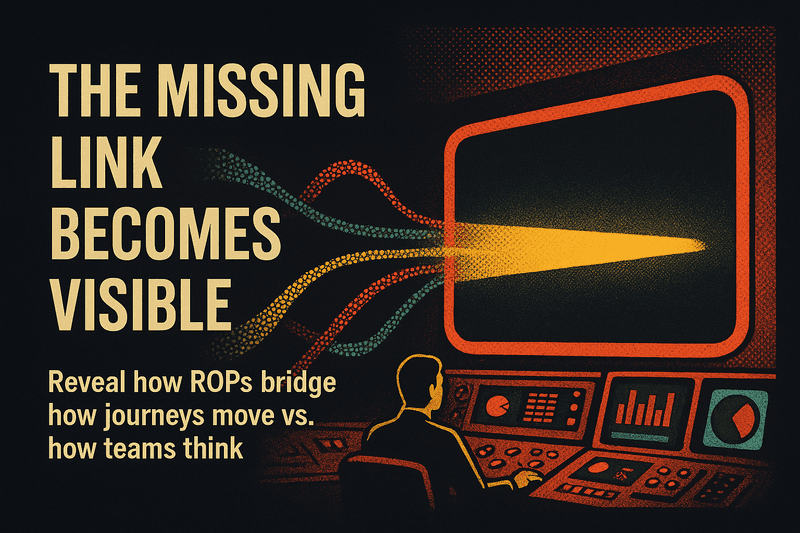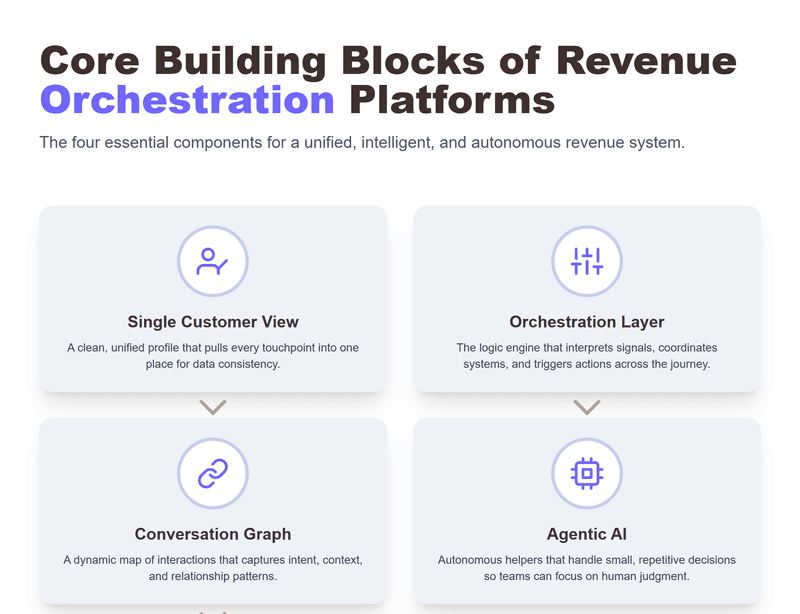Revenue Orchestration Platforms: What They Do and Why They Matter Today

Most GTM problems don’t come from a lack of effort, they come from teams acting on broken or delayed customer signals. Revenue orchestration fixes the timing.
Someone once joked that managing a GTM engine feels like trying to direct traffic in a city where every streetlight runs on a different power grid. Funny thing is, they weren’t wrong. Most teams still juggle disconnected tools, scattered data, and customer journeys that seem to wander off on their own. And that’s exactly where revenue orchestration platforms step in.
If you’ve been wrestling with inconsistent handoffs or trying to stitch together insights from a half-dozen dashboards, you already know the pain. A revenue orchestration platform doesn’t magically fix everything overnight, but it does give you something better than a survival strategy. It gives you a working model of how customers move, what they need, and how your teams respond in real time.
If you’re curious whether your current stack could work a little smarter, keep reading. There’s a simpler path hiding in plain sight.
What are Revenue Orchestration Platforms
Revenue orchestration platforms are often described as the missing link between how teams think customers move and how customers actually move. At their core, they connect the dots that usually stay scattered. Instead of marketing running a campaign here, sales following up there, and retention trying to make sense of whatever is left, an ROP pulls everything into one coordinated flow.
You can think of it as a layer that sits quietly across your stack. It listens to every interaction, keeps the context intact, and nudges the right team to act at the right moment. Not by flooding people with tasks, but by translating customer signals into decisions that make sense.
If you’ve ever wished your GTM tools would actually talk to each other, this is where things start to feel possible.
Core Building Blocks of Revenue Orchestration Platforms
Single Customer View
A clean, unified profile that pulls every touchpoint into one place so teams stop operating on conflicting data.
Orchestration Layer
The logic engine that interprets signals, coordinates systems, and triggers actions across the journey without manual juggling.
Conversation Graph
A dynamic map of interactions that captures intent, context, and relationship patterns far beyond static CRM fields.
Agentic AI
Autonomous helpers that handle small, repetitive decisions so teams can focus on moments that actually require human judgment.
If these pieces sound straightforward, that’s the point. Orchestration works best when the foundation stays simple and predictable.

How Revenue Orchestration Platforms Work Throughout the Customer Lifecycle
When every team sees the same real-time customer truth, the lifecycle stops feeling like a relay race and starts working like one connected motion.
Marketing: Identifying Signals Early
ROP picks up intent signals, enriches profiles, and routes leads with the right context. It prevents cold starts by giving sales an informed entry point instead of another mystery contact.
Sales: Guiding the Right Next Step
As conversations unfold, the platform updates the conversation graph and prompts timely actions. Nothing fancy, just simple nudges that keep deals from stalling or slipping through cracks.
Retention: Spotting Risk Before It Shows Up
ROP surfaces early signs of churn or expansion potential, using behavior patterns rather than last-minute support tickets. Teams get a chance to act before the customer drifts.
Operations: Keeping Everything Aligned
Ops finally get a system that syncs tools, reduces manual patchwork, and keeps workflows from breaking when the GTM motion shifts.
Why Revenue Orchestration Platforms Are Gaining Momentum
Companies aren’t adopting ROPs because they’re shiny. They’re adopting them because the old way has stopped working. Customer journeys zigzag across channels, tools multiply, and teams end up spending more time fixing handoffs than moving deals forward.
Three shifts are driving the momentum. The first is data overload. Teams have more information than ever, but very little of it connects. The second is the rise of real-time expectations. Buyers won’t wait days for a response that should’ve taken minutes. And the third is AI maturity. Platforms can finally interpret signals and automate low-value decisions with enough accuracy to be useful.
Put simply, the stack is getting smarter, and teams need a system that can keep up with how people actually buy.
Key Capabilities to Evaluate in Revenue Orchestration Platforms
Quality of the Single Customer View
Look for platforms that merge data cleanly, resolve duplicates, and maintain context across channels. A messy foundation turns every downstream workflow into guesswork.
Strength of the Orchestration Layer
The platform should interpret signals, trigger actions, and sync systems without constant admin work. If it breaks every time your process changes, it’s not orchestration, it’s overhead.
Depth of the Conversation Graph
You want more than transcripts or notes. A solid ROP captures intent, timing, sentiment, and relationship patterns so teams can act with context rather than assumptions.
Practical Use of Agentic AI
The focus isn’t smart-sounding features. It’s whether the AI can handle small, repetitive decisions reliably and hand off the important ones to humans.
Integration Speed and Stability
Fast connections, low latency, predictable behavior. Without this, your workflows won’t stay aligned.
If you evaluate platforms through these lenses, the right choice usually becomes clear long before the demo ends.
Myths, Misconceptions, and Challenges
It’s just another automation tool
Not quite. Automation handles tasks. Orchestration coordinates journeys. One is tactical, the other is structural, and confusing the two sets expectations in the wrong direction.
It replaces CRM or MAP systems
ROPs don’t replace core systems. They sit above them, giving everything a shared rhythm so teams stop patching gaps with manual fixes.
AI will make decisions we can’t control
Agentic AI inside ROPs works within guardrails. It handles the small, predictable choices and leaves the judgment calls to people who understand the account.
Implementation takes forever
The tougher part isn’t deployment. It’s untangling old workflows, cleaning data, and getting teams aligned on what “good” looks like.
If these misconceptions have held your team back, treating them as assumptions worth testing is usually the fastest way to move forward.
Conclusion & What’s Next
Revenue orchestration gives brands a clear way to close data sillos, unify customer teams, and replace disconnected workflows with one coordinated system. When marketing, sales, and retention operate from the same signals, every handoff becomes smoother, every interaction becomes more relevant, and revenue becomes far more predictable. It moves companies from reactive fixes to a repeatable, aligned growth motion.
Looking ahead, orchestration will lean even more on real-time intelligence, automated decisioning, and cleaner shared data layers. Platforms will shift from simply connecting steps to actively guiding teams on the next best action across the lifecycle. Brands that invest early will not only stop revenue leakages, they’ll build a scalable, always-on engine that supports faster, more efficient growth.